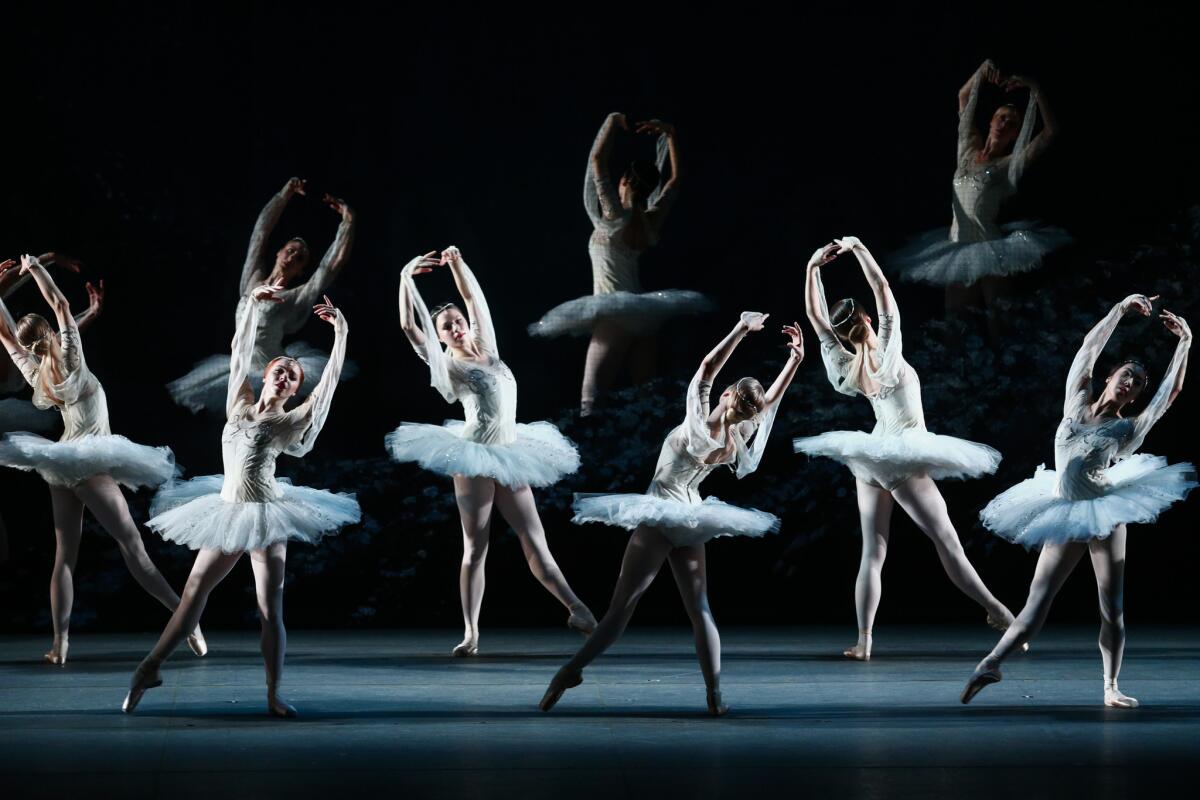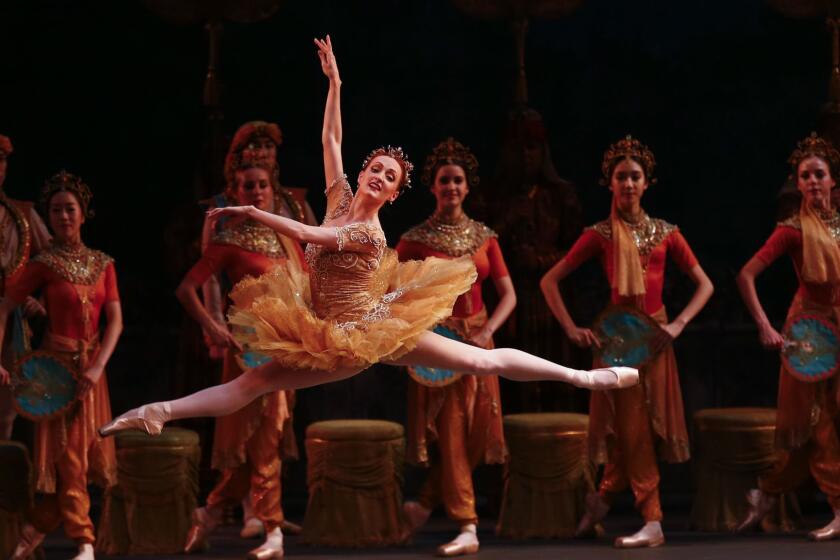How Mariinsky Ballet preserves the legacy of its 142-year-old ‘La Bayadère’
- Share via
“La Bayadère” is one of ballet’s classic works, the 1877 tale of a warrior torn between duty and love. From its origins at the Mariinsky Ballet, the Russian company that dates to the 1740s, “La Bayadère” or excerpts from it have been staged around the world — the Royal Ballet in London, the Paris Opera Ballet, American Ballet Theatre in New York.
The Mariinsky Ballet and Orchestra is performing the work through Sunday at the Segerstrom Center for the Arts in Costa Mesa, before the troupe moves to the Music Center in downtown Los Angeles to dance George Balanchine’s 1967 “Jewels” on Oct. 24-27.
With a piece like “La Bayadère,” how does a classical company authentically re-create art from so long ago, especially when, unlike drama and music, ballet has no standardized system for recording the work? The history of classical ballet, including “La Bayadère,” is based on “porous sources,” passed from body to body, said Linda Tomko, emerita professor of dance at UC Riverside.
The original source of “La Bayadère” is choreographer Marius Petipa. The 19th century Frenchman, often called the father of classical ballet, created more than 50 full-length ballets, including “Raymonda,” “The Sleeping Beauty” and “Don Quixote.”
After being named the Mariinsky’s principal ballet master in 1869, Petipa made “La Bayadère” to showcase the talent of his favorite ballerina, Yekaterina Vazem.
Told through a European’s view of ancient India, the four-act ballet centers on the ill-fated relationship between noble warrior Solor and temple dancer Nikiya. Neither the choreography nor the music, composed by Ludwig Minkus, referenced traditional Indian dance or music.
At the time of its premiere, the work was a dazzling spectacle with colorful sets and props, elaborate costumes and a mix of choreographed dance scenes and pantomime — a key characteristic of Petipa’s ballets.
“La Bayadère” is best-known for its haunting Kingdom of the Shades scene. After Nikiya is killed by rival Gamzatti, Solor — in an opium-induced daze — dreams of his lost love. Clad in white, the corps de ballet descends a ramp to the stage in a diagonal snaking pattern, repeating a meditative sequence of arabesques and port de bras.
Petipa choreographed “La Bayadère” at the height of his powers, said ballet historian and Washington Ballet scholar-in-residence Natalie Rouland.
“We can see it as sort of an iconic ballet of the period,” she said “It was particularly opulent in its splendid display of India and thus appealed to the sensationalist ballet-goers at the time.”
Over its 142-year history, “La Bayadère” has undergone numerous reconstructions. Petipa made changes to the ballet himself in 1884 and again in 1900. In the 20th century, the fourth act, in which an earthquake sent from the gods collapses temple walls, was largely scrapped.
The 1941 revision by Vladimir Ponomarev and Vakhtang Chabukiani for the Mariinsky (then called the Kirov) became one of the most well-known productions of the ballet — the version performed by the Mariinsky today.
The reconstruction kept Petipa’s core choreography and relics of the past — plush tigers and elephants on wheels — but was altered to meet Soviet tastes at the time.
Ponomarev and Chabukiani added more challenging choreography to show off the abilities of male dancers, said the Mariinksy‘s acting director, Yuri Fateev. In the 19th century, men weren’t dancing much onstage, Fateev said. “The ballet was created especially for the ballerinas.”
In Petipa’s original version, ballerinas performed the Kingdom of the Shades in heeled shoes, later changed to pointe. Other changes include the Dance of the Golden Idol, which was added by Nikolai Zubkovsky in 1948.
Ponomarev and Chabukiani were “gentle with the original Petipa choreography, but they made something new in his choreographical language,” Fateev said. The director considers the Mariinsky presentation of “La Bayadère” one of the best in the world, “because the influence of Petipa is still in this production.”

“La Bayadère” was unknown in the West until 1961, when the Kirov performed the Kingdom of the Shades in Paris.
In 2002, Mariinsky ballet master Sergei Vikharev reconstructed “La Bayadère” based on the original notation system created by Mariinsky dancer Vladimir Stepanov in 1892. But the dance was largely rejected.
More than 20 of Petipa’s ballets, including “Swan Lake” and “The Sleeping Beauty,” were transcribed using the Stepanov system. After the Russian Revolution, Stepanov’s student Nikolai Sergeyev used the notations to reconstruct Petipa’s works throughout Europe from the 1920s to the 1940s. In the 1960s, the notations were sold to Harvard University, and they are now housed in the Harvard Theatre Collection.
“It’s controversial in Russia to reconstruct ballets — original Russian ballets — but on the notation that was removed from Russia,” historian Rouland said.
In recent years, “La Bayadère” has raised questions over cultural stereotypes and insensitive depictions of India.
In his 2018 review of American Ballet Theatre’s L.A. performance of the work, Times dance critic Lewis Segal wrote that it “depicts ancient India as a realm of unprincipled fancy-dress barbarism, akin to Petipa’s treatment of Egyptians in ‘Pharaoh’s Daughter,’ Turks in ‘Le Corsaire’ and Arabs in ‘Raymonda.’”
The justification for these works, including “La Bayadère” and “Le Corsaire,” Rouland said, is “the dazzling virtuoso choreography of particular scenes.” It’s the reason why pieces like the Kingdom of the Shades are often extracted and shown alone, “removed from the cultural context of the whole ballet itself.”
Seeing classical ballet is one way to “assess change,” retired professor Tomko said. Productions of “La Bayadère” and other ballet works aren’t “just reproducing a static past, but they enable us as viewers to possibly discern change and see where it is the ballet speaks to current situations, maybe where ballet doesn’t.”
Mariinsky Ballet and Orchestra's 'La Bayadère'
Where: Segerstrom Center for the Arts, 900 Town Center Drive, Costa Mesa
When: 7:30 p.m. Thursday-Friday, 1 and 7:30 p.m. Saturday, 1 p.m. Sunday
Tickets: $39-$199
Info: www.scfta.org
Also: Mariinsky performs George Balanchine’s “Jewels” at the Music Center’s Dorothy Chandler Pavilion, 135 N. Grand Ave., Los Angeles. Performances are at 7:30 p.m. Oct. 24-25, 2 and 7:30 p.m. Oct. 26, 2 p.m. Oct. 27. $34-$138 (subject to change). (213) 972-0711 or www.musiccenter.org.
More to Read
The biggest entertainment stories
Get our big stories about Hollywood, film, television, music, arts, culture and more right in your inbox as soon as they publish.
You may occasionally receive promotional content from the Los Angeles Times.












